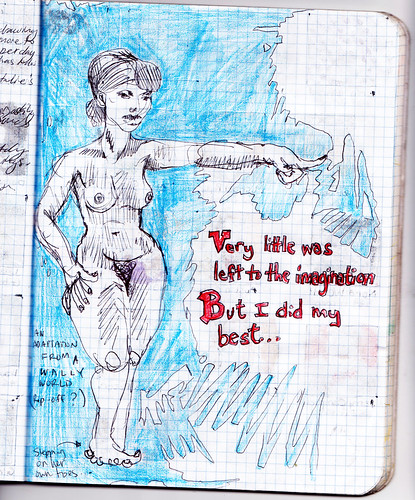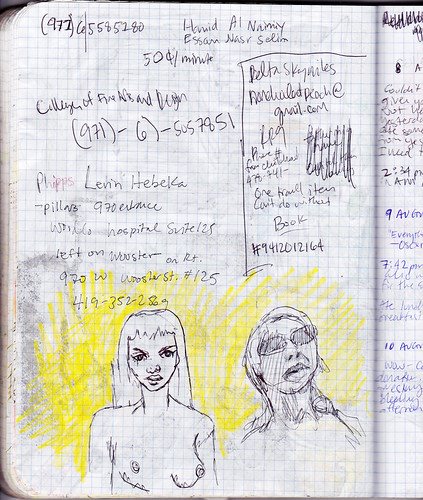Below is a list of random things I overheard or read and wrote down in large text in this red graph paper sketchbook I’ve been working in. They all feel significant to me for some reason. Most of them have drawings beside them and function as sort of captions. They probably don’t mean much of anything to you.
- “Very little was left to the imagination…. but I did my best.”
- “Oh, No, Honey!…”
- “Country Living in an apartment in Ohio.”
- “In my defense, fuck this guy.”
- “Look at the donkey!”
- “Red is a cloak of invisibility in the deep.”
- “Underwater dogs.”
- “Experimental Cactus.”
They only mean something to me because the drawings they are beside. That’s how I used to have to memorize facts in science class in school: I’d learn them by the picture they were next to, which I could perfectly recall in my memory.
These aren’t so much facts, though. More like ephemera of my memory. I have kept sketchbooking over these many years for a variety of reasons: one of them is because I’d never remember anything otherwise. Truly. Especially the order in which things happen. Sometimes I feel as if a giant memory eraser follows me around for all of my days, and all I’m left with are those little crumbles of eraser dirt to ponder.
Marrying someone with a good memory has helped. I often now say in conversation, however, “Ask me again when Blake is here. He’ll remember.” A heavy burden for him to bear! Being my brain! But I try to pay him back in websites and printing.
Another big part of my sketch-booking is not only to keep a record of what has happened in my life, but also to keep a record of what I have eaten/watched/read/etc. As it happens, I’ve read two fantastic art-y books in recent weeks. One is the graphic novel by Ben Katcher, The Cardboard Valise.
“A young curator from the Museum of Accidental Art’s Stains and Maculation Department happens to be dinning at the next table.”
There are no page numbers in this book, I just realized. (It’s part of my sketchbook documentation to keep note of the page number, text, author, and other pertinent details of each quote I record. As if I’m writing some giant research paper… Or working as a research assistant for someone who is. Maybe one day I will be.)
The writing reminds me a little of Edward Carey. When reading it, you keep thinking you’ve skipped a page and end up turning back and forth and licking your finger and trying to separate the paper leaves until you realize that’s just the way the story goes.
At first, The Cardboard Valise gives you semblance of a narrative, and then it breaks down into some sort of non-linear anthropological discussion of an imaginary culture. You soon realize that the book is conditioning you to read in a new way, eschewing your desire for sensical connections.
You hungrily gobble up frames full of quirky images, moments, professions, and past times. A blip in reality, 2D vs 3D existence, the thrill of an uncharted geographical territory in a bustling metropolis, a man who cannot decide where to eat dinner.
It is as if an entire city has been packed into my brain as a child, and it is not just a record, but some sort of thriving little world that continues to change and move about. People continue to check their mail, fart, and stand for hours in the grocery store wondering what type of pasta to buy this week. Maybe this is what it feels like to be a fiction author. I’ve read that many just sit and “listen to what [their] characters have to say to [them].” They’re not “making it up.” It is more like a dimension in the universe is just bending and touching another branch.
I’m actually not done with the book yet. I’d tell you how far along I am but, again, no page numbers. I am into it, in any case. I’m just having trouble balancing out all the things I do in a day. What I need to do, what I want to do, what am I supposed to be doing?
The other art-y book I read recently (and did finish, in one long stretch of reading in the park, busily jotting down quotes in my notebook as I went) is Sketch Books: The Hidden Life of Designers, Illustrators & Creatives, by Richard Brereton. I wrote down quotes, of course. Sketchbooks within sketchbooks within sketchbooks. How “meta.”
The page numbers are giant sans serif black figures.
“For me, a sketchbook is like a kind of portable laboratory, a space to mark with references to capture the immediate, to experiment, a memory warehouse to which I can return whenever I am searching for an idea or when I simply want to remember an instant, a time in the past.”
–Pep Carrio, p. 46
“Keeping sketchbooks helps me to empty my brain while making connections between ideas without judgement. Once something is in my sketchbooks, I can forget about it, and then find it later.”
“My sketchbooks allow me to be free, to express myself without boundaries. In a way my sketchbooks are far removed from the reality, as everything can be included and quality is not important.”
–Frederique Daubal, p. 52
“My sketchbook comes with me absolutely everywhere. It has become part of my identity and leaving it at home amputates part of me.”
-Henrik Delehag, p. 66
“Over time, I gradually began looking outwards less, and my drawing came more and more from my own imagination, like the drawings I made as a child. My observations now have more to do with the way people behave and how this makes me feel, rather than how things look.”
“It is a constant ally in my never-ending war against emptiness and logic.”
-Dominic Del Torto, p. 62
“For me producing a sketchbook is a bit of trickery. I trick myself into thinking it’s just a little sketchbook. That no one else will see it. I can draw in it, write what I like in it. This, surreptitiously, allows me to create pictures without inhibition. However, the reality is that underneath that veil, I hope to produce something truly worthwhile.”
–Marion Deuchars, p. 72
And, relating back to the beginning of this post:
“My sketchbook party trick is to draw what I see and write what I hear. A funny sound bite can make a drawing unexpected and slightly twisted. Just like me”
–Flo Heiss, p. 142
I copied down many more quotes, of course. Several pages worth. I won’t even read them all again now because then I will want to type them all in here. And you’ve probably had enough, right? If not, go check out the book from your local Library.
And I’ve been illustrating my own life, by hook or by crook. Copying, dreaming, scribbling, scratching and obliterating reality piece by piece.
I just took a tub bath at 9 o’clock in the morning. My skin is hot. It’s quiet outside. All I hear are occasional cars and singsong crickets down in the cold grass below my windows. It’s a gray rain sky today, and I’m thankful that my box fan is faithfully importing the temperate air into our stuffy apartment.
I’m currently drinking some iced coffee at the table by our big picture window looking out onto the ugliest apartment complex in Bowling Green, Ohio. So let’s have a toast:
Here’s to sketchbooking! Yours and mine.
For More Inspiration, See Also:
- Robert Nicol
- Simon Spilsbury
- Holly Wales
- Fumie Kamijo
- A Look Inside the Sketchbooks of 10 Terrific Creatives
- Seb Jarnot
- Joakim Drescher
- Andrea Dezso
P.S. It’s the 8th Anniversary since Katrina hit today… Crazy.













I will definitely be checking out these books and artists. Great suggestions and very inspiring. Thanks so much for sharing!
Thanks for reading! And I hope you enjoy the books! The “Sketchbook” one really opened my eyes to a lot of new illustrators’ work that I hadn’t seen before!
Pingback: My First Zine: “Dear Google, What is the Cutest Puppy Ever?” And Other Drawings | Orange Barrel Industries